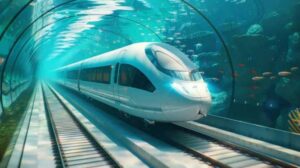🚄 Dubai to Mumbai in 2 Hours? UAE’s 1,000 km/h Underwater Bullet Train Dream! 🌊
Imagine traveling from Dubai to Mumbai in just 2 hours—underwater! This dream might soon become a reality as the United Arab Emirates (UAE) explores a revolutionary 2,000-kilometer underwater high-speed rail project. With a proposed speed of 1,000 km/h, this floating bullet train could completely transform travel and trade between the two powerful South Asian nations.
A Visionary Project: Underwater Bullet Train Between Dubai and Mumbai
The UAE is known for its bold and futuristic infrastructure projects—and this one tops the list. The proposed Dubai-Mumbai underwater train aims to connect the UAE’s bustling commercial hub with India’s financial capital through a submerged corridor, offering travelers a fast, luxurious, and eco-friendly alternative to air travel.

This isn’t just a dream—it’s part of the UAE’s long-term vision for global connectivity and sustainable development. Feasibility studies are already underway, led by a combination of Emirati and international engineering firms to determine whether this ambitious venture can move forward.
Key Features of the Dubai to Mumbai Underwater Train
- Distance: Approximately 2,000 kilometers (1,242 miles)
- Estimated Travel Time: 2 hours
- Speed: Up to 1,000 km/h
- Route: Submerged tunnel under the Arabian Sea, linking Dubai (UAE) to Mumbai (India)
- Technology: Magnetic levitation (Maglev) or similar ultra-high-speed rail systems
- Purpose: Passenger travel, goods transportation, and even water and oil exchange
Economic and Cultural Impact
1. Boost to Tourism and Business
Cutting down travel time to just 2 hours would greatly benefit tourism, business travel, and bilateral trade. Travelers could attend a morning business meeting in Mumbai and be back in Dubai by evening.
2. Trade Route Enhancement
This train route could also serve as a fast track for goods transportation, reducing dependency on cargo ships and airplanes, and speeding up delivery times for businesses on both sides.
3. Energy and Resource Exchange
One unique aspect of this project is the exchange of resources: the UAE could supply oil to India, while India could supply water to the UAE via pipelines integrated into the rail tunnel.
Challenges Ahead
While the project is incredibly exciting, it comes with significant challenges:
- High Construction Costs
- Extreme Engineering Complexity
- International Cooperation
- Safety and Environmental Concerns
Experts estimate that such a project would require cutting-edge tunneling technology and massive financial investment, possibly in the hundreds of billions of dollars.
The Future of Transportation?
If successful, the Dubai to Mumbai underwater bullet train could become a benchmark for future international infrastructure projects. It would redefine travel, showcasing what’s possible when innovation meets ambition.
Final Thoughts
The Dubai-Mumbai underwater train project is still in the planning and feasibility stage, but its potential to revolutionize travel in the region is undeniable. With the backing of futuristic thinkers and government leaders, this dream could soon glide beneath the Arabian Sea—bringing two nations closer than ever before.
